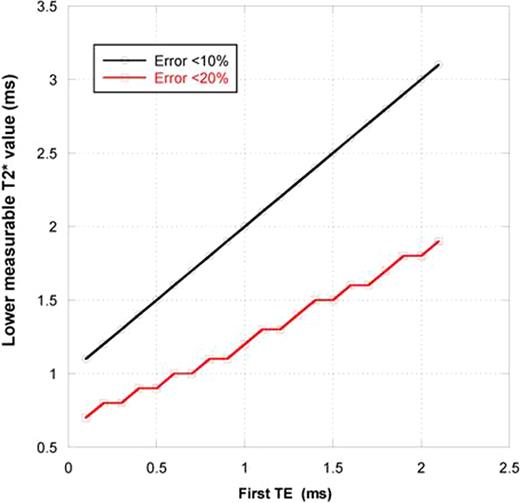Abstract
Abstract 5169
T2* multiecho cardiovascular magnetic resonance (CMR) is largely used to assess iron overload in heart because of the established inverse relationship between the T2* value and the iron concentration in tissues (Wood JC et al, Hemoglobin 2008). The decay of CMR signal is sampled at several echo times (TEs) and the T2* is inferred by fitting the decay curve to an appropriate model (Positano V et al, NMR in Biomed 2007). Our aim was to quantify the reliance on TEs of the expected error in T2* value determination.
The Cramer-Rao lower bounds theory (CRLB) was used. CRLB provide a fundamental limit to the accuracy in determination of the T2* value from experimental data in dependence of SNR at signal samples. CRLB were evaluated for a commonly used multi-echo sequence with the first TE equal to the minimum achievable (1.4-2 ms), ΔTE of about 2.3 ms to minimize the fat-water interface artifacts, 10 echoes to assure acquisition in a single breath-hold.
Percent error in T2* values assessment was lower than 10% in the range of clinical interest, with the exception of very low T2* values. Precision in measurement of low T2* values is strongly dependent on the value of the first TE, that is limited by the used scanner. T2* values greater than 1.8 ms and 1.5 ms can be assessed with an error below 20% using a first TE of 2 ms and 1.5 ms, respectively (see Figure).
T2* multiecho sequences used in clinical practice assure an acceptable precision for T2* values ≥ 2 ms, depending from the used hardware. This limit includes almost all patients with hemochromatosis or hemosiderosis in country where the patients can be well managed. For patients with very high myocardial iron overload sequences with lower minimum echo time and/or lower echoes interval may be useful.
No relevant conflicts of interest to declare.
Author notes
Asterisk with author names denotes non-ASH members.


